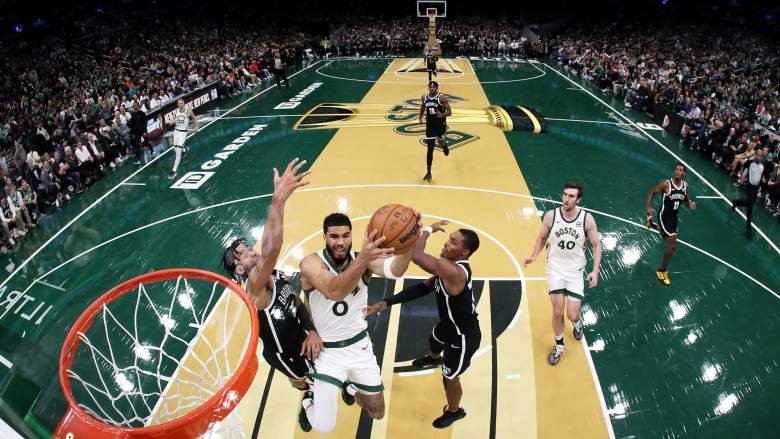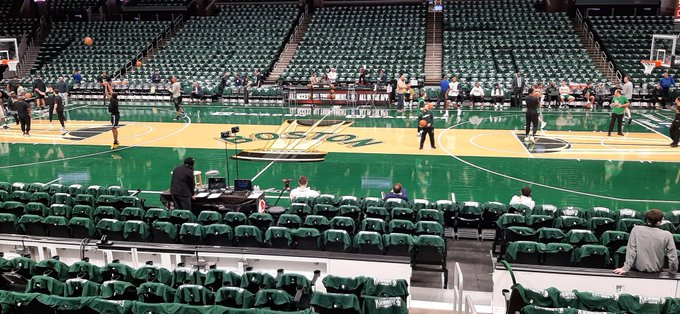
BOSTON — Last Friday’s game had yet to tip off, but everyone had gotten an eyeful of the Boston Celtics‘ version of the NBA In-Season Tournament floor. The reaction on social media was, uh, not positive.
The green stripes covering the outer thirds of the playing surface from end to end helped create a shock for those who hadn’t seen images released by the team and NBA prior. A shot taken from the stands with my phone’s camera got more than one million views on Twitter/X, and I noted it was the first time the club had played a game on Causeway Street (Gardens old and new) without a parquet floor.
And when Heavy Sports broke the news that the Celtics had asked the league for permission to paint a parquet pattern on the lighter middle strip and were turned down, the matter exploded.
The responses were littered with anger — some of it quite creative (one suggested “NO PARQUET, NO PEACE,” while another spoke of making commissioner Adam Silver do the one-chip challenge). F-bombs abounded. If my notifications that night had a soundtrack, it would have been the Boston Pops and the Fourth of July fireworks finale from the Esplanade.
NBA Should Have Allowed Boston Celtics Parquet
A four-choice poll seeking reaction to the court was won easily by “Fkng blasphemous” with more than 65 percent of the vote. Strange, Great, and Disconcerting were far behind. Finally, an issue to unite our country… or at least Celtic Nation.
Traveling back five paragraphs to the pregame moment, the floor and the In-Season Tournament as a whole were the basis for quite a bit of discussion at the tables in the media/staff dining area, particularly after our report that the parquet touch had been denied. One Celtic type figured my opinion on all of it could be assumed, that I’d hate it.
Not entirely.
Without question, the league should have allowed some proper homage to the parquet — quite easily the most famous and enduring hoop court design in history. It didn’t have to scrap its general floor concept for the IST, garish though it freaking is.
But overall I get what the NBA is trying to do with the event and wish it good luck. And if it’s for a few games in November and early December, I think we should be able to live with it.
In this case, it’s not about us.
Not about me, who’s loved the game nearly all my life (mom used to say I was dribbling before I was drooling — and she had the headaches to prove it).
Not about you, who’s reading a hoop story during FOOTBALL SEASON, goshdarnit.
Basketball already has us. We’re in. We’re watching.
The NBA has a lock on adults who get mad at referees in October and kids who carry a ball to school and learn geography by charting James Harden’s trade demands.
Not All Pay Attention to the NBA Before Christmas
But many fans of sport in general hold back their interest for a while, waiting for Santa to slide down the chimney and tell them it’s OK to watch the NBA. During the 2011 lockout, I nearly spent enough time in New York to establish voting residence, dutifully hanging out at various league/players association meeting sites and reporting the day’s stalemate.
When slipping home for a day or two and even on the shuttle flights, my stock answer to every labor-related question was, “There will be NBA games on Christmas Day.”
At 12 p.m. on December 25, 2011, the Celtics and Knicks took the court in Madison Square Garden. That TV spotlight wasn’t going to be missed.
So now the league wants to create the basketball equivalent of the WWE’s Intercontinental champion, albeit in this case with each player from the winning team getting $500,000 instead of a nifty belt.
If it works, there will be TV ratings and a better hand for the NBA to play when negotiating the next rights deals. At the end of the line it’s about money. Kinda always is. And growth is important.
Interest in a particular sport can wane, with baseball having long ago given up the throne. And if you run across some very old folks, ask them to tell you how horse racing used to own the nation’s attention for more than three Saturdays a year.
NBA Was Once Looking at Contraction
The NBA has made huge strides since the start of the David Stern era, but there are still some people who can recall when the league was in serious discussions about contraction in the early ’80s — and that was after Larry and Magic had begun the roundball renaissance.
Stern pushing to grow the brand and develop the overseas markets (remember the McDonald’s Open?) and getting the league’s players into the Olympics has led to Giannis and Luka and Joker and Dirk and Pau and so many others. It’s not just importing players, but also ideas… like soccer’s in-season tournaments.
Holding tight to the past is cool, but even the past begets change, because the bar is continually reset. I played a high school game in the old Garden on the original parquet floor, so it means something to me. But I knew its time had passed in 1995 and that it wouldn’t be making the trip next door to the new building.
Heck, I was also bugged a bit when the Celtics stopped wearing black sneakers, a practice that had its roots to the time when teams provided the shoes, and Red Auerbach realized he’d have to replace the darker ones less often because they didn’t look as dirty.
But that went out the window when players started getting big shoe deals, and the companies wanted to differentiate their brands. This was good for NBA business, because when Nike, Adidas, Converse, et al were promoting their stars, they were also promoting the NBA.
‘Merchandising! Merchandising!’
I think some stuff is utterly silly, but we’ve all long ago realized that allowances have to be made — ignoring the changing ads on the court, hockey boards and pitcher’s mound, etc. — to enjoy the basic sports we’ve followed for years. The old Oakland A’s yellow sleeveless uniforms and white shoes look like something out of a 1950s Brooks Brothers catalog next to the hurl-inducing alternate duds some teams dare wear in public now.
As Mel Brooks’ character so eloquently says in Spaceballs, “Merchandising! Merchandising!”
The multiple fashion options and sensory overload game presentation and endlessly tweaked All-Star Weekend festivities aren’t going anywhere. (Still waiting for Mike Zarren and the league’s capologists guessing the luxury tax for random sets of players without going over, Price is Right style.)
The NBA is always seeking ways to drive revenue, and it has smart people thinking up ways to do it.
Indeed, I’m very much a basketball purist, but change isn’t necessarily evil. As media and fans, we can measure it against the past and offer guardrails — let them know when we think they’re veering into the crazy lane. Sometimes the ideas are good, or at least harmless enough to be worth a fair trial, and not recognizing that can leave you by the side of the road while the world speeds by with someone you’ve never heard of blasting on the radio.
The serenity prayer tells us to accept that which we cannot change. And if calling the people who denied the Celtics’ court request a bunch of nearsighted fools with no regard to history or fear of Red Auerbach flicking cigar sparks on them from The Great Skybox isn’t enough to get a little parquet added to that floor, well, I took my shot.



















Comments
OK, You Hate Celtics’ Parquet-Free Court; But Is NBA’s In-Season Tourney All Bad?